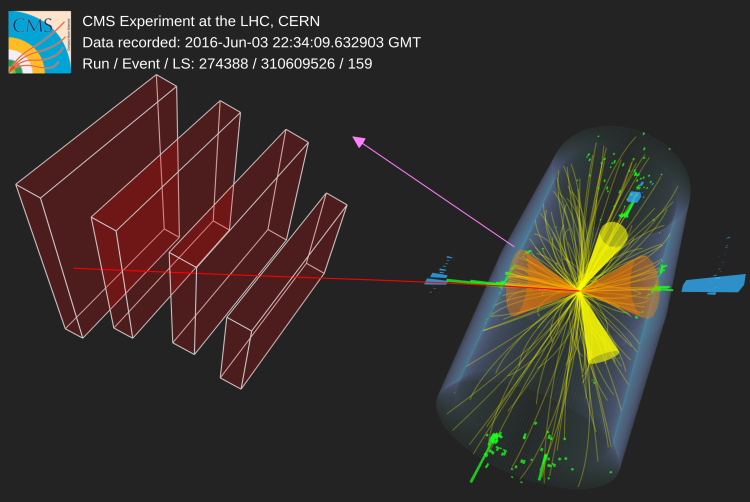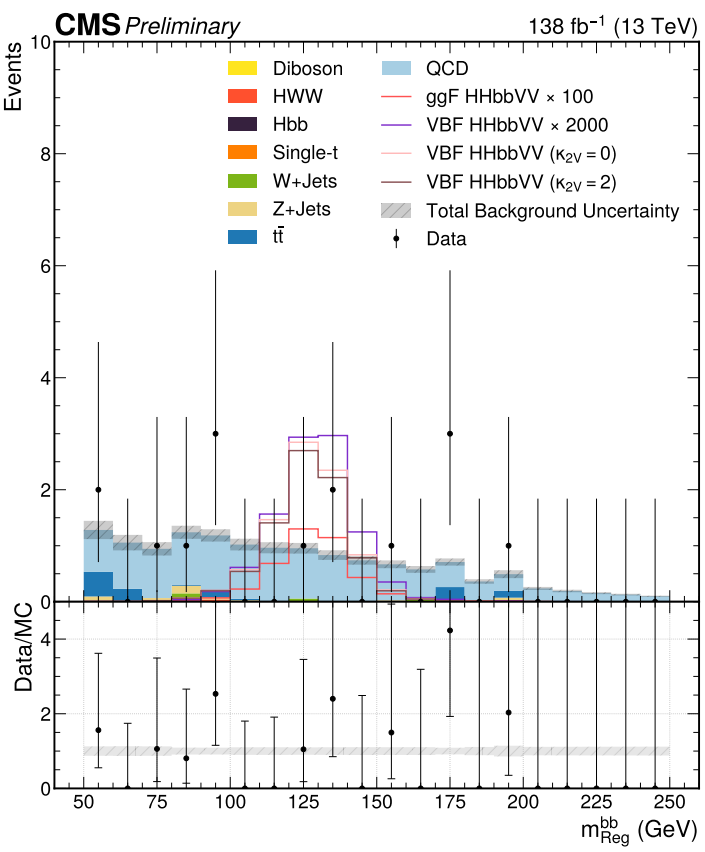
A principal goal of the LHC and its high-luminosity upgrade is measuring the Higgs boson interaction with itself. Observing the production of pairs of Higgs bosons is the best way of experimentally establishing this and other Higgs boson interactions. Due to the unstable nature of the Higgs boson, pairs of Higgs bosons can be measured in myriad ways depending on how each Higgs boson decays. Searching for a pair of Higgs bosons when both have high energies can also help reduce the backgrounds and enhance potential new physics effects.
Most of the time, about 34%, a pair of Higgs bosons will result in four bottom quarks. The second most likely outcome, about 13%, is two bottom quarks (H→bb) and two W or Z bosons that then decay to two quarks each (H→WW/ZZ→4q). Each quark creates a spray of particles, which can be clustered together so that, for example, at high energies, H→4q results in a single jet. However, this mode has not been studied before despite the large fraction of events. The challenge is that H→4q jets are hard to identify: they may look similar to jets originating from quarks and gluons, especially if one or two quarks are lost. Thus, determining the origin of these jets is critical.
Figure 1: A candidate signal event in data, showing a H→bb candidate large-radius jet and a H→4q candidate large-radius jet (both as orange cones). Two small-radius jets more aligned with the beamline indicate the fusion of W or Z bosons. The event display is interactive, you can zoom and rotate it, also on this separate page.
A new machine learning breakthrough---the transformer---has been critical to changing how we can look for Higgs bosons. This model was developed to parse natural language, learning each word’s hidden meaning based on the context provided by all the other words in a given phrase. This approach is called “attention” because the model can focus on certain parts of the input data, giving more weight to crucial features and disregarding unimportant ones. We can apply the same approach to identify Higgs bosons, giving rise to the Global Particle Transformer (GloParT) algorithm.
With this tool in hand, the search was performed for a pair of highly energetic Higgs bosons, one decaying as H→bb, and the other one as H→4q. The main observable is the mass of the jet, identified as most likely originating from H→bb (Figure 2). In the presence of an HH signal, we expect to see a peak near the mass of the Higgs boson at approximately 125 GeV. The search targets two ways of producing two Higgs bosons at the LHC: from the fusion of gluons or the fusion of W or Z bosons. The latter mode is less common but has the unique signature of two quarks produced near the beamline and alongside the Higgs boson pairs.

Figure 2: Distribution of the H→bb candidate jet mass in the W or Z boson fusion signal region for the data (black data points), expected backgrounds (filled histograms), and different potential signals (empty histograms).
No signs of new physics were observed, and no new constraints were set on the Higgs boson self-interaction. However, the search has set strong constraints on new physics scenarios involving the production of highly energetic Higgs bosons through the fusion of W or Z bosons.
Written by: Javier Duarte, for the CMS Collaboration
Edited by: Muhammad Ansar Iqbal
Read more about these results:
-
CMS Physics Analysis Summary (HIG-23-012): "Search for highly energetic double Higgs boson production in the two bottom quark and two vector boson all-hadronic final state"
-
Display of collision events: CERN CDS
-
@CMSExperiment on social media: Bluesky - Facebook - Instagram - LinkedIn - TikTok - Twitter/X - YouTube

